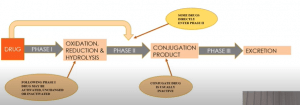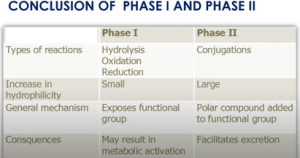XENOBIOTIC METABOLISM AND TOXICITY
WHY XENOBIOTIC METABOLISM IS REQUIRED?
- Essential to excrete the accumulation of toxic compounds (xenobiotics) from the body.
- Through this, a substance is changed from one chemical to another chemical through a chemical or enzymatic reaction within the body.
RESULTS OF XENOBIOTIC METABOLISM
- The solubility of xenobiotics is changed. They become more soluble and result in easy excretion of these toxic compounds.
- The metabolic reactions help in facilitating the excretion
- The metabolic activities change the chemical structure of xenobiotics making them less toxic or easy to excrete.
PURPOSE OF BIOTRANSFORMATION OF XENOBIOTICS
- Metabolism from more to a less toxic chemical is called biotransformation.
- The change in the chemical structure of xenobiotics makes it easier to be excreted.
ELIMINATION ROUTES OF XENOBIOTIC METABOLISM
- Urine, bile, stool
- By lungs
- Excretion into human milk
ORGANS INVOLVED IN XENOBIOTIC METABOLISM
- Gall bladder
- Intestine
- Liver
- Kidney
ROLE OF LIVER IN XENOBIOTIC METABOLISM
- Liver cells contain various types of enzymes to process xenobiotics.
- Hepatocytes contain a gene that is induced by different xenobiotics.
PATHWAYS FOR EXCLUDING XENOBIOTIC
- ELIMINATION UNCHANGED – Excretion of compounds without any change in a living organism. Hydrophilic and lipophilic xenobiotics can be excreted through this pathway
- RETENTION UNCHANGED – The xenobiotics get stored in bone and body fat. They do not excrete out of the body.
- SPONTANEOUS CHEMICAL TRANSFORMATION – The xenobiotics need some chemical changes for their excretion.
- ENZYMATIC METABOLISM – Xenobiotics undergo various enzymatic reactions and then get excreted.
MECHANISM OF XENOBIOTIC METABOLISM
- When the drug enters the organism. It then enters phase I metabolism.
- In phase I the drug undergoes oxidation, reduction, and hydrolysis reactions.
- This changes the solubility of the intake compound. This leads to an easy excretion of the toxic compound.
- After the series of reactions, the drug enters phase II metabolism.
- After the phase I metabolism drug becomes prodrug, which when enters phase II metabolism gets attached to a functional group.
- This makes the prodrug inactive.
- This process is known as the conjugation stage. The products of this stage then enter into phase III metabolism.
- Just after entering phase III, the products get excreted out from the living organism’s body.
- There are certain compounds that are directly toxic to the body and they enter into phase II metabolism without entering the first phage. Eg: some pesticides.

PHASES OF XENOBIOTIC METABOLISM
Phase I (BIOTRANSFORMATION)
- Biotransformation of any toxic compounds inside the body produces a less toxic compound which can be further easily absorbed/excreted.
- Certain enzymes are involved in this phase, like Cytochrome P450, located in liver cells.
- Phase I includes three basic reactions: oxidation, reduction, and hydrolysis.
- The combination of these reactions leads to a change in the solubility of the toxic compound.
- Aldehyde and alcohol dehydrogenase, deaminases, esterase amidase, and epoxide hydrolase are some other enzymes used in Phase I.
- 2D6 is one of the forms of Cytochrome P450 that is mainly involved in the metabolism of xenobiotics.
Phase II (CONJUGATION)
- The toxic compounds undergo conjugation and their polarity is changed.
- The polarity and water solubility of these compounds get increased which helps in an easy excretion.
- Small polar endogenous molecules such as glucuronic acid, sulfate, or glycine covalently attach to the toxic compound and convert them to more water-soluble compounds.
- Basic reactions in phase II are Glucuronidation, Acetylation, Sulfation, and Methylation.
- In glucuronidation reaction, the glucuronic group gets attached to the toxic compounds and increases their polarity.
- Toxic compounds with amino, hydroxyl, and sulfhydryl groups undergo acetylation which increases their polarity and solubility.
- The entry of the toxic compounds somehow disturbs the methylation process inside the body. To manage this disturbance, certain methyl groups get attach to the toxic compounds in Phase II of xenobiotic metabolism making them less toxic to attack the natural methylation process.

FACTORS AFFECTING XENOBIOTIC METABOLISING ENZYMES
- Pregnancy
- Age
- Gender
- Polymorphisms
- Organ transplant
- Liver Diseases
- Kidney Diseases
- Drug-drug interaction
- Inflammatory mediators
- Diabetes Miletus
REFERENCES
